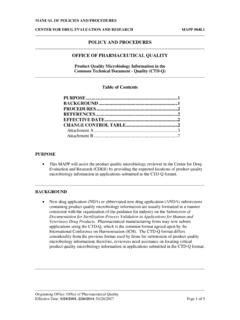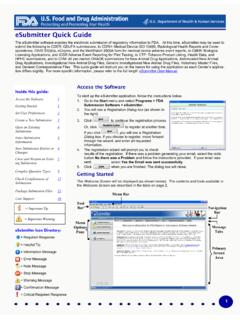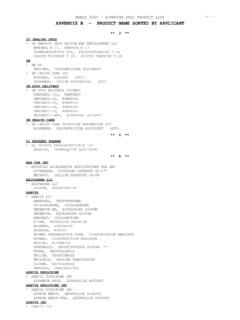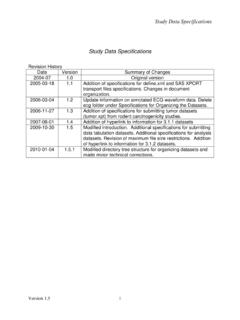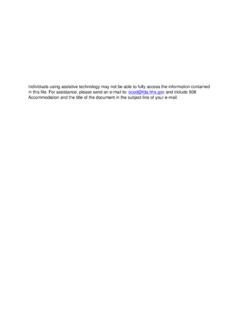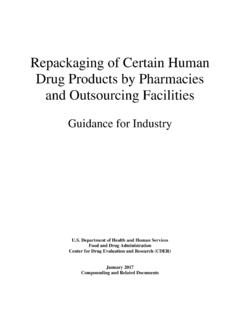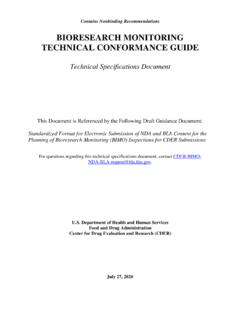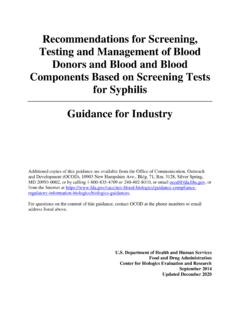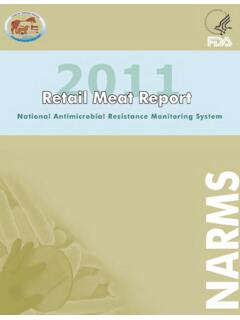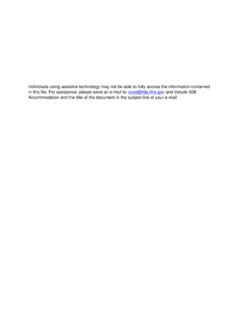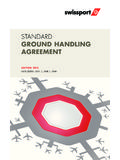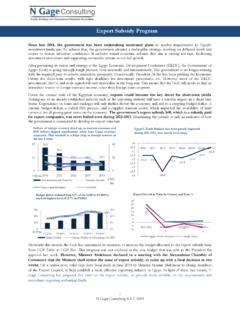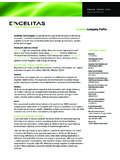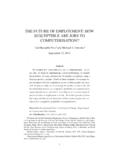Transcription of Menu Labeling: Supplemental Guidance
1 Contains Nonbinding Recommendations 1 Menu Labeling: Supplemental Guidance for Industry Additional copies are available from: Office of Nutrition and food Labeling, HFS-800 Center for food Safety and Applied Nutrition food and drug administration 5001 Campus Drive College Park, MD 20740 (Tel) 240-402-2373 You may submit written comments regarding this Guidance at any time. Submit electronic comments to Submit written comments to the Dockets Management Staff (HFA-305), food and drug administration , 5630 Fishers Lane, rm. 1061, Rockville, MD 20852. All comments should be identified with the docket number [FDA 2011 F 0172] listed in the notice of availability that publishes in the Federal Register. Department of Health and Human Services food and drug administration Center for food Safety and Applied Nutrition May 2018 Contains Nonbinding Recommendations 2 Table of Contents 1.
2 Introduction 2. Background 3. Calorie Disclosure Signage for Self-Service Foods, Including Buffet Foods 4. Criteria for Distinguishing Between Menus and Marketing Materials 5. Methods for Providing Calorie Disclosure Information 6. Compliance and Enforcement 7. Determining Nutrient Content for Standard Menu Items 8. Covered Establishments 9. Standard Menu Items 10. Alcohol 11. References Contains Nonbinding Recommendations 3 Menu Labeling: Supplemental Guidance for Industry1 This Guidance represents the current thinking of the food and drug administration (FDA or we) on this topic. It does not establish any rights for any person and is not binding on FDA or the public. You can use an alternative approach if it satisfies the requirements of the applicable statutes and regulations. To discuss an alternative approach, contact the FDA staff responsible for this Guidance as listed on the title page.
3 1. Introduction This Guidance document addresses concerns raised by stakeholders regarding the implementation of nutrition labeling required for foods sold in covered establishments,2 including expanded and new examples of alternatives to aid in compliance. It also clarifies that there are additional options for complying with the labeling requirements and identifies places where FDA intends to be more flexible in its approach. The Guidance reflects input from stakeholders, including the public and industry, in response to an interim final rule (IFR) (82 FR 20825, May 4, 2017), as well as comments received on the draft Guidance document. The IFR also extended the compliance date for menu labeling, and invited comments to the docket. In addition, given extensive further analysis by FDA, Questions and Answers and have been withdrawn from our previous April 2016 Guidance entitled A Labeling Guide for Restaurants and Retail Establishments Selling Away-From-Home Foods Part II (Menu Labeling Requirements in Accordance with FDA s food Labeling Regulations): Guidance for Industry.
4 In this Guidance , we address the issue of distinguishing between menus and other information presented to the consumer, which represents our current thinking on this topic. This Guidance also includes many graphical depictions in order to convey our thinking on various topics. The Guidance covers several topic areas including calorie disclosure signage for self-service food , including buffets and grab-and-go food ; various methods for providing calorie disclosure information, including those for pizza; criteria for distinguishing between menus and marketing material; compliance and enforcement; reasonable basis, including the criteria for considering the natural variation of foods, when determining nutrition labeling; criteria for covered 1 This Guidance has been prepared by the Office of Nutrition and food Labeling in the Center for food Safety and Applied Nutrition at the food and drug administration .
5 2 21 CFR (a) defines covered establishment as a restaurant or similar retail food establishment that is a part of a chain with 20 or more locations doing business under the same name (regardless of the type of ownership, , individual franchises) and offering for sale substantially the same menu items, as well as a restaurant or similar retail food establishment that voluntarily registers with FDA to be covered by the federal menu labeling requirements. See generally 21 343(q)(5)(H)(i). Contains Nonbinding Recommendations 4 establishments; and standard menu items. Finally, as a result of our further analysis of the menu labeling requirements and, in particular, the nutrient declaration requirements for the additional written nutrition information in 21 CFR (b)(2)(ii)(A) that requires calories from fat be declared for standard menu items, and to align with the final rule, food Labeling: Revision of the Nutrition and Supplement Facts Labels, 81 FR 33742 et seq, we are advising covered establishments of our intent to exercise enforcement discretion regarding the calories from fat declaration requirement.
6 This means that, during this period, we do not intend to enforce this regulatory provision as it currently applies to calories from fat declarations. We are taking this position because the current science supports a view that the type of fat is more relevant with respect to the risk of chronic disease than the overall caloric fat Therefore, if a covered establishment meets all of the provisions of the menu labeling requirements for the additional written nutrition information in 21 CFR (b)(2)(ii)(A), except that calories from fat is not declared, we do not intend to pursue actions against the covered establishment. We are issuing this Guidance consistent with our good Guidance practices (GGP) regulation (21 CFR ). With respect to our enforcement discretion policy pertaining to calories from fat declarations, this part of the Guidance is immediately effective because we have determined that prior public participation is not feasible or appropriate (21 CFR (g)(2)).
7 FDA s Guidance documents, including this Guidance , do not establish legally enforceable responsibilities. Instead, guidances describe our current thinking on a topic and should be viewed only as recommendations, unless specific regulatory or statutory requirements are cited. The use of the word should in FDA guidances means that something is suggested or recommended, but not required. 2. Background On December 1, 2014, we published a final rule in the Federal Register (79 FR 71156) on nutrition labeling of standard menu items in restaurants and similar retail food establishments to implement the menu labeling provisions of section 403(q)(5)(H) of the Federal food , drug , and Cosmetic Act (FD&C Act). The menu labeling requirements are codified at Title 21 of the Code of Federal Regulations, section (21 CFR ). Before these requirements, consumers could find nutrition information on most packaged foods; however, this labeling was not generally and consistently available in restaurants and similar retail food establishments that serve ready-to-eat, prepared food .
8 Providing calorie and other nutrition information for ready-to-eat prepared foods in restaurants and similar retail food establishments will enable consumers to make informed and healthy dietary choices. The original compliance date for the menu labeling provisions was December 1, 2015. On July 10, 2015, we extended the compliance date to December 1, 2016 (80 FR 39675). On December 18, 2015, the Consolidated Appropriations Act (Pub. L. 114-113) was adopted. It contained a 3 FDA s current thinking on this issue is discussed in the preamble to the final rule titled, food Labeling: Revision of the Nutrition and Supplement Facts Labels (81 FR 33742 at 33780 through 33781 (May 27, 2016) (now codified primarily at 21 CFR and )). Contains Nonbinding Recommendations 5 provision stating that none of the funds made available under the Consolidated Appropriations Act could be used to implement, administer, or enforce the menu labeling final rule until one year after FDA issued a final Guidance document regarding the rule.
9 We issued the final Guidance document on May 5, 2016. In accordance with Congress s direction, we subsequently set the compliance date for the rule as May 5, 2017, one year from the date of the publication of the Guidance (81 FR 96364). On May 4, 2017, we published an interim final rule (IFR) (82 FR 20825) in the Federal Register extending the compliance date to May 7, 2018, in response to the diverse and complex set of stakeholders affected by the rule and questions they raised regarding the final rule and its implementation (Refs. 1, 2, 3, and 4). The IFR provided additional time to support industry innovation and to ensure consistency across establishments when delivering nutrition information to consumers. Our goals are to ensure that consumers are provided with consistent nutrition information they can use to make informed choices for themselves and their families, and to guide industry to clearly understand the flexible way the requirements can be implemented.
10 Comments to the draft Guidance were received until January 8, 2018, and incorporated, as appropriate, to this Supplemental Guidance . This Guidance provides clarity to the industry on these remaining questions ahead of the new compliance date of May 7, 2018. 3. Calorie Disclosure Signage for Self-Service Foods, Including Buffet Foods We are a covered establishment that has a self-service buffet. Are we required to have individual signs ( , food tags) next to each buffet item with the calorie declaration? Answer: No. You are not required to have individual signs next to each buffet item. While the menu labeling final rule requires calorie information for each buffet item that is a standard menu item, the menu labeling final rule is flexible, and allows the calories for self-service foods and foods on display to be declared in a variety of ways, as long as the consumer can view the name, calorie declaration, and serving or unit of a particular menu item while selecting that item.
